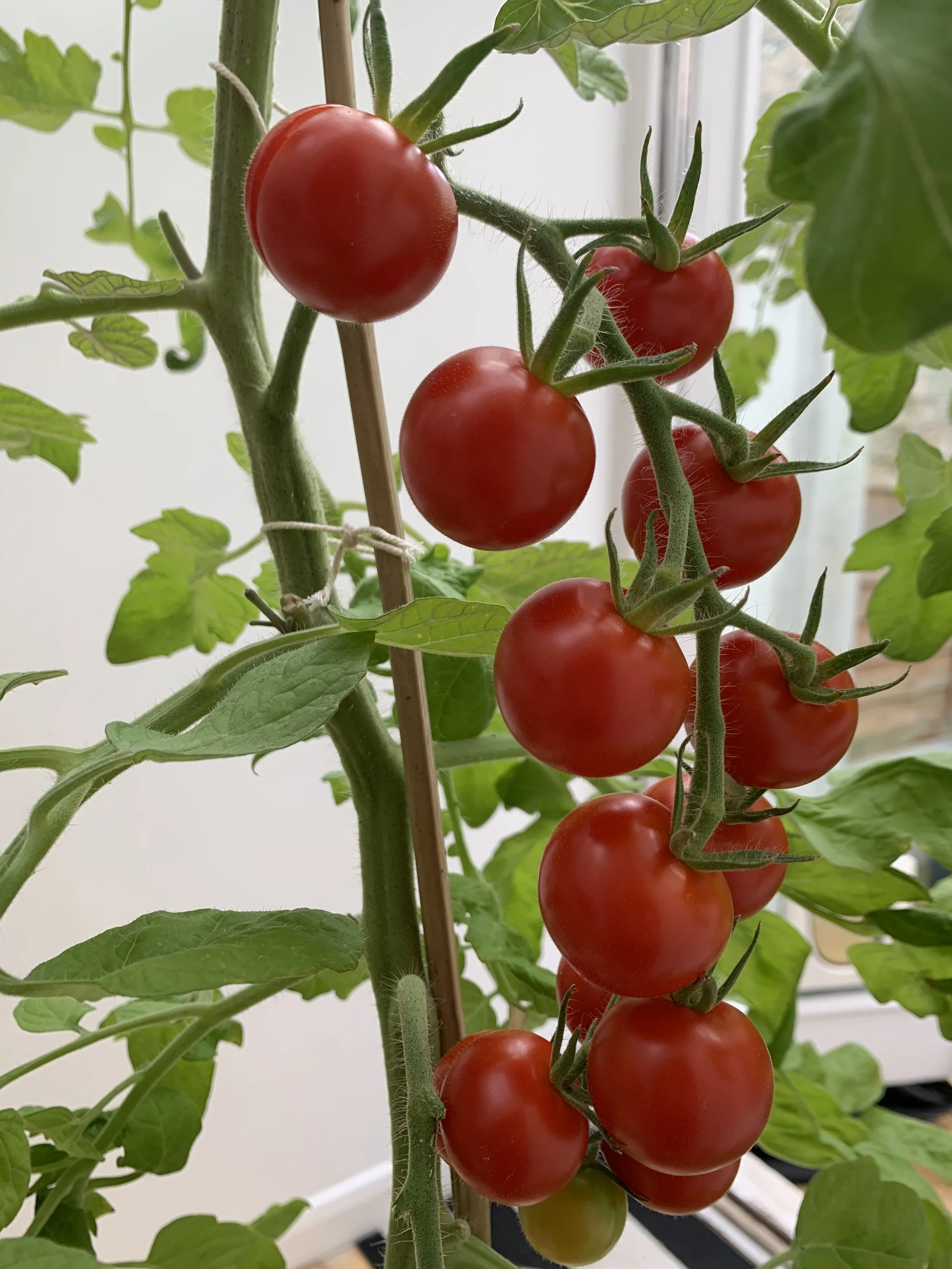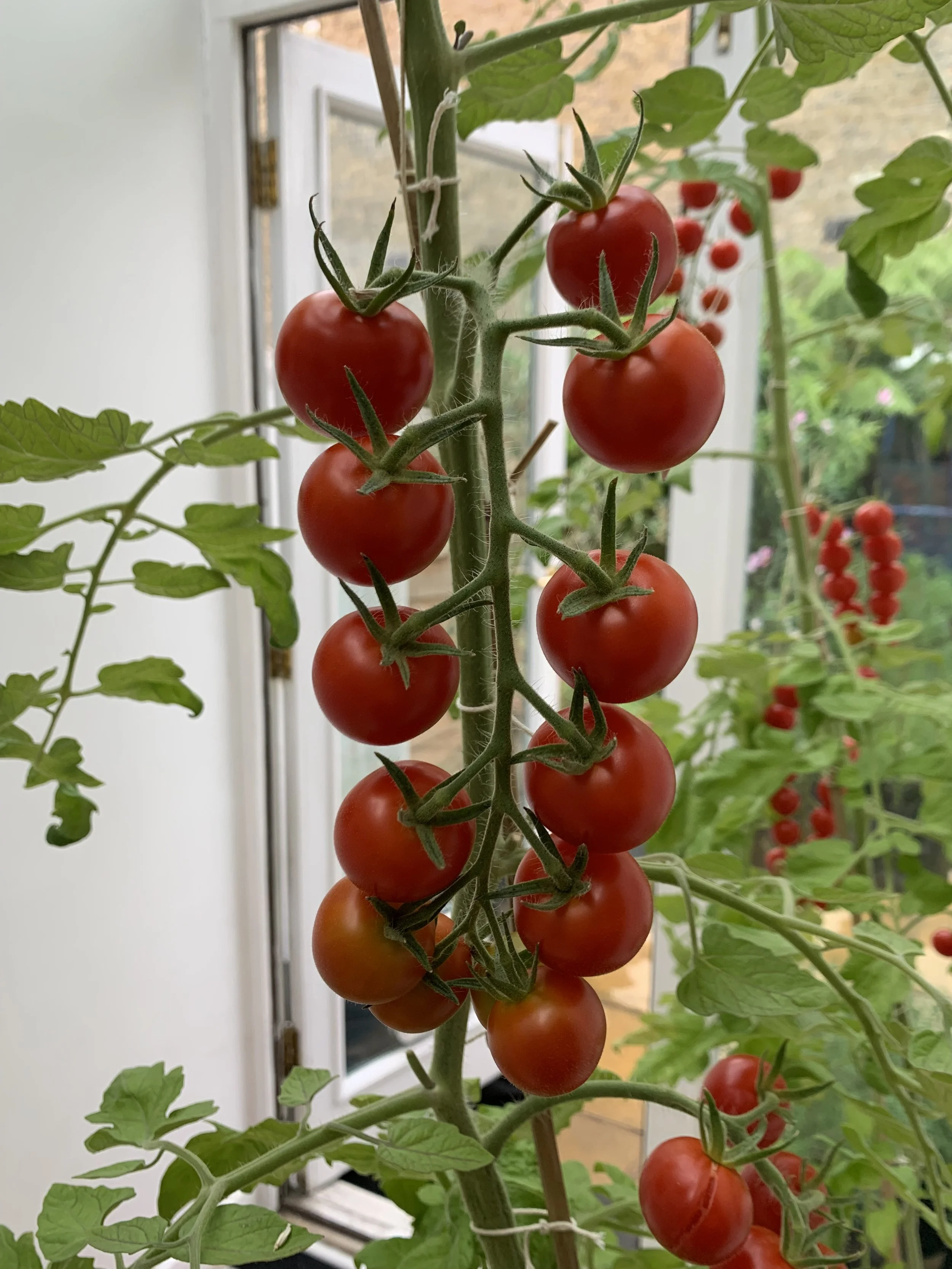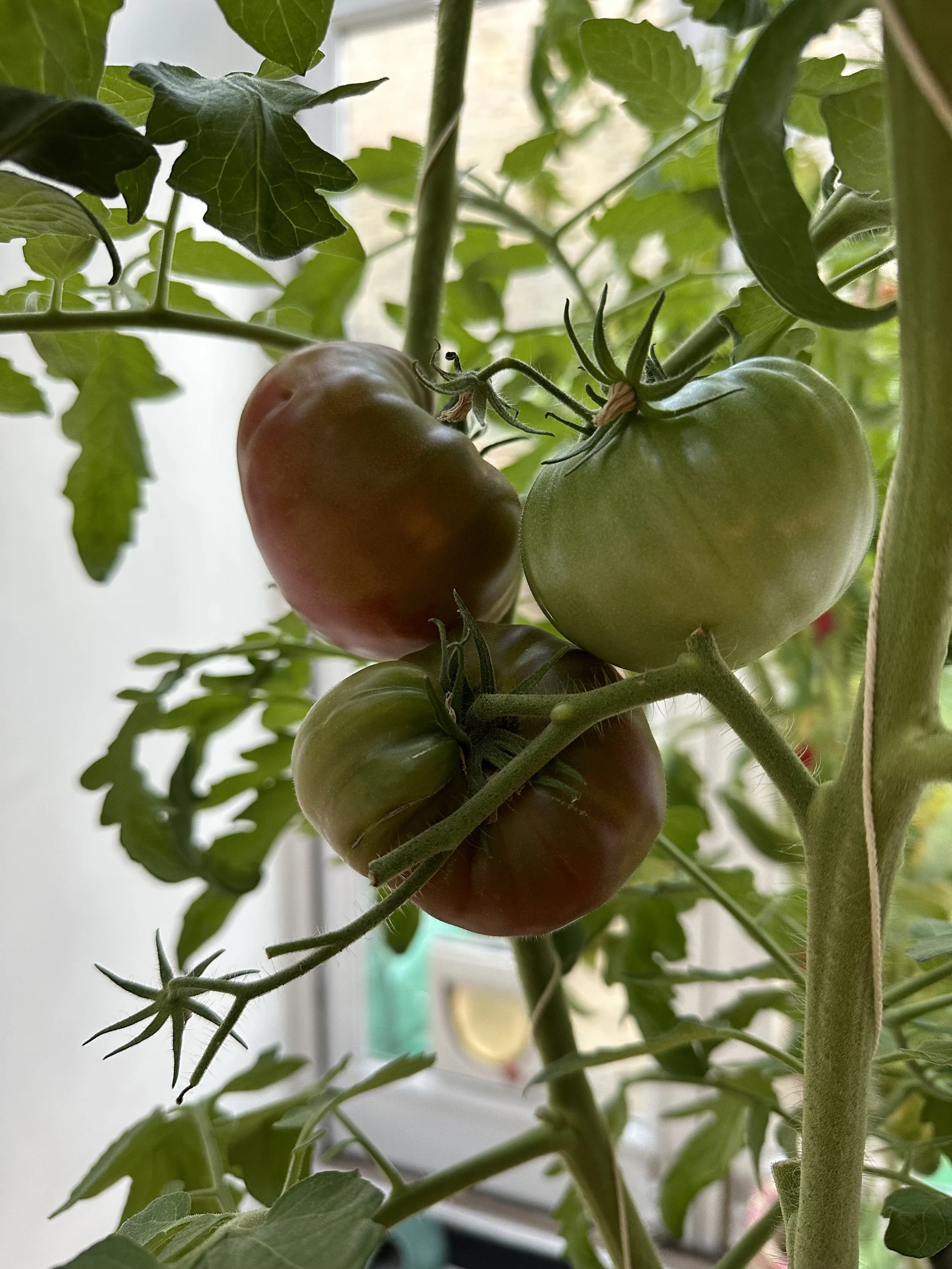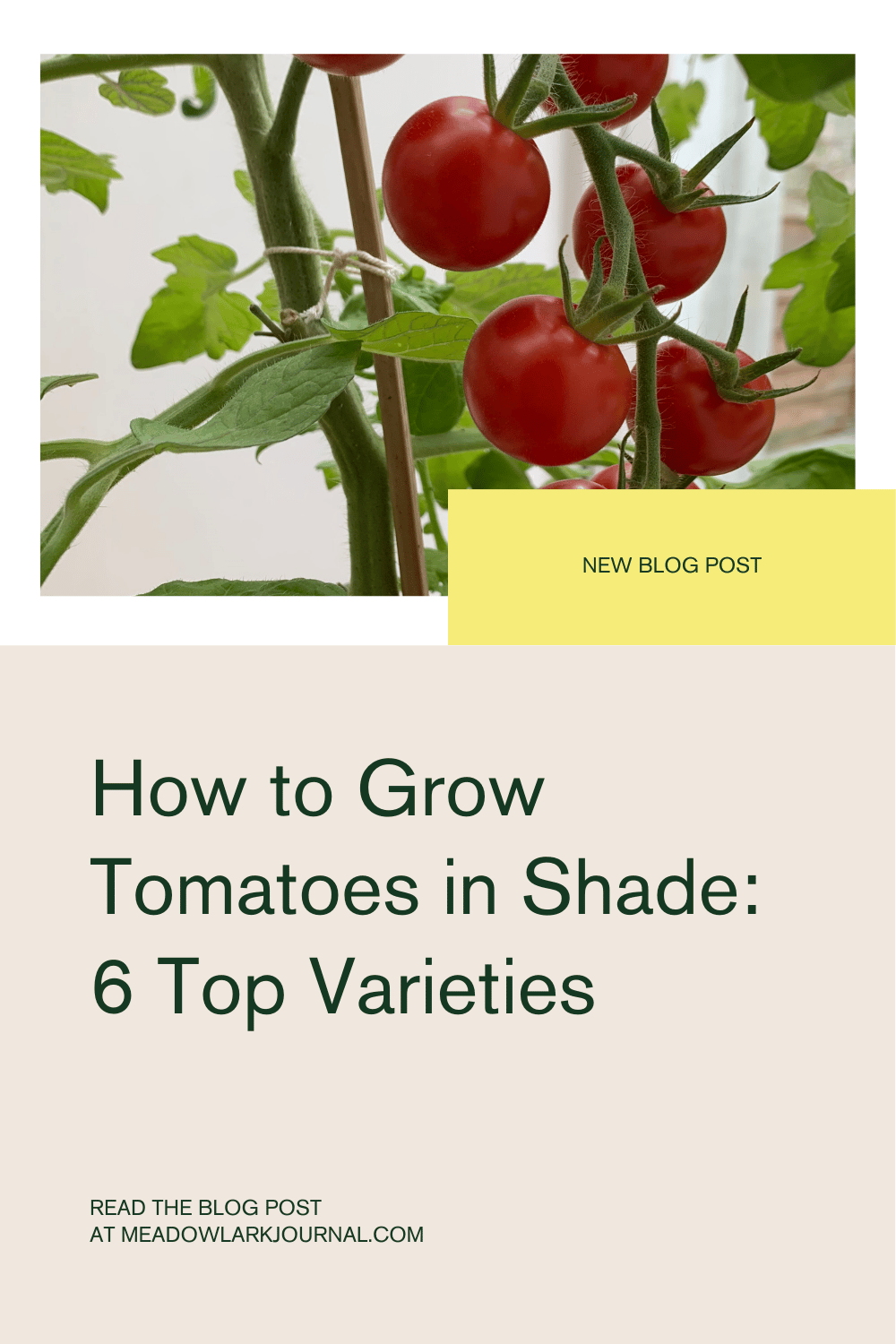Growing Tomatoes in Shade: Top 6 Varieties
This website is reader-supported - thank you! This post may contain affiliate links. As an Amazon Associate, I earn from qualifying purchases at no extra cost to you.
When it comes to growing tomatoes, the common advice is to find a spot that basks in full sun and to avoid putting your tomatoes in shade.
However, not all gardens are bathed in sunlight, and not all tomato growers have the luxury of endless sunny days.
In this guide, we explore the world of shade-friendly tomatoes, which can flourish even with limited direct sun exposure.
Discover how to maximize your harvest and enjoy delicious tomatoes from parts of your garden that receive less light.
To learn more about growing tomatoes, check out my guides:
Quick Homemade Tomato Fertilizer
Understanding Light Requirements for Tomatoes
Tomato plants are generally classified as full-sun lovers, which means they ideally require at least six to eight hours of direct sunlight per day to thrive.
Sunlight plays a crucial role in the plant's growth, affecting everything from the size and flavor of the fruits to the plant's overall health and resistance to pests and diseases.
However, not all gardens can provide such abundant sunlight.
Here's what you need to know about how tomatoes handle different lighting conditions:
Direct Sun vs. Partial Shade:
While the ideal scenario for a tomato plant involves ample direct sun, many varieties can still produce fruit with less.
In terms of light intensity, 'direct sun' refers to unfiltered, continuous sunlight for the majority of the day.
'Partial shade', on the other hand, implies that the plant will receive filtered sunlight or direct sunlight for only a part of the day.
This could mean dappled sunlight filtered through trees or a few hours of direct sun interspersed with periods of shade.
Effects of Insufficient Sunlight:
Tomato plants that do not receive enough sunlight may exhibit several growth-related issues.
They could grow taller and appear leggier as they stretch toward the nearest light source, which generally results in weaker plants.
To learn more about this, check out my guide: Leggy Tomato Seedlings: Causes and Solutions.
Additionally, a lack of sufficient sunlight can lead to fewer blossoms and, consequently, fewer fruits.
The fruits that do develop might be smaller and less flavorful compared to those grown under ideal conditions.
Adaptability of Different Varieties:
Some tomato varieties have adapted to less-than-ideal light conditions better than others.
For instance, smaller-fruited types, such as cherry and grape tomatoes, require less energy for fruit production and can manage with slightly less sunlight.
These varieties are often more forgiving when it comes to lower light conditions, making them suitable choices if you are dealing with partial shade.
Monitoring and Managing Light:
It’s essential to observe their garden’s light patterns throughout the growing season.
The angle of the sun changes, affecting how light falls in your garden.
This understanding can help in strategically placing tomato plants where they will receive the maximum possible sunlight.
Additionally, using reflective mulches such as silver plastic can help increase light availability to tomato plants by reflecting sunlight onto the foliage from the ground.
By understanding these light requirements and the adaptability of tomato plants, you can make informed decisions about which varieties to plant and where to place them in the garden to optimize their exposure to sunlight, even in less-than-ideal conditions.
This strategic approach can significantly improve the chances of a successful and fruitful tomato harvest, even in shaded gardens.
Equip your urban green space with my recommend top tier tools.
To learn more about growing tomatoes, check out my guides:
The Art of Harvesting Tomatoes: When and How to Pick the Perfect Fruit
When to Start Tomato Seeds Indoors
Best Tomato Varieties for ShadY Gardens
Growing tomatoes in shaded areas might sound challenging, but certain varieties are known to be more adaptable to these conditions.
Here’s a deeper look at some of the best tomato varieties that can thrive even with limited sunlight, making them ideal choices if you don't have the perfect sun-drenched spot.
Black Krim:
This heirloom variety is known for its dark, almost black fruits that offer a rich, sweet flavor with a hint of smokiness.
Black Krim tomatoes can tolerate lower light levels better than many other heirloom varieties.
They need around 4-5 hours of sunlight to produce a decent yield, making them a suitable option for gardens that receive partial sunlight.
Here are the Black Krim seeds I recommend:
Cherry Tomatoes:
Due to their smaller fruit size and faster ripening time, cherry tomatoes are among the best choices for shadier conditions.
Varieties like 'Sweet Million,' 'Tiny Tim,' and 'Sungold' can manage with about 3-4 hours of direct sunlight.
Their smaller size means they require less energy to develop fruits, which is an advantage in lower light environments.
Here are the ‘Tiny Tim’ tomato seeds I recommend:
Roma Tomatoes:
Roma, or plum tomatoes, are robust and versatile, famous for their use in sauces and pastes.
They can perform reasonably well in partial shade, requiring slightly less sun than larger fruiting varieties.
With about 4-5 hours of sunlight, they can still produce a substantial crop.
Their determinate growth habit, meaning they grow to a fixed height, makes them easier to manage in confined or shaded spaces.
Here are the Roma tomato seeds I recommend:
San Marzano:
Another plum tomato variety, San Marzano, is highly prized for its sweet flavor and low acidity, making it ideal for canning and sauces.
Like Roma tomatoes, they can cope with partial shade conditions and still yield a good harvest, though the fruits may be smaller and the total yield less than in full sun.
Here are the San Marzano seeds I recommend:
Bush Early Girl:
This is a bush-type tomato that is compact enough for container gardening and small spaces.
It’s an early ripener, which can benefit from even limited sun exposure.
Requiring around 4 hours of sunlight, this variety can produce fruit consistently throughout the season.
Here are the Bush Early Girl seeds I recommend:
Oregon Spring:
This variety is tailor-made for cooler climates and less sunny gardens.
It's a determinate tomato plant that sets fruit at lower temperatures and can produce a respectable yield with limited sunlight.
When choosing tomato varieties for shadier gardens, it's also crucial to consider other factors like local climate, soil health, and plant care practices.
These can all influence how well your tomatoes will adapt to lower light conditions.
By selecting the right types and managing your garden environment thoughtfully, you can enjoy a rewarding tomato harvest even from the shadier corners of your garden.
To learn more about growing tomatoes, check out my guides:
The Best Companion Plants for Tomatoes
Tips for Growing Tomatoes in Shade
While tomatoes typically prefer full sun, with thoughtful gardening techniques, you can successfully grow tomatoes even in shaded areas of your garden.
Here is how to optimize the growth and fruit production of tomatoes in less-than-ideal sunlight conditions:
Maximize Available Light:
Observe Light Patterns:
Spend a few days observing the patterns of light and shade in your garden.
This will help you identify spots that receive the maximum amount of available sunlight throughout the day.
Use Reflective Surfaces:
Placing reflective materials, such as aluminum foil, white plastic, or specialized garden reflectors around your plants can help increase the amount of sunlight they receive by bouncing light back onto the foliage and fruit.
Here is the reflective material I recommend using:
Choose Strategic Plant Locations:
Edge Planting:
Plant tomatoes on the edges of shaded areas where they might catch additional light from the open areas of the garden.
Vertical Growing:
Employ trellises, stakes, or cages to encourage your tomato plants to grow upwards towards the light, which can also help improve air circulation and reduce disease risks.
Here are the tomato cages I recommend:
Adjust Watering Practices:
Monitor Soil Moisture:
Shaded areas may retain moisture longer due to reduced evaporation rates.
It’s important to check the soil moisture regularly to avoid overwatering, which can lead to root rot and other fungal diseases.
For more watering tips, check out my guide: How to Use Watering Globes.
Mulch Wisely:
Using organic mulch can help maintain an even soil temperature and moisture level, but be mindful of the thickness of the mulch layer.
In shaded areas, a thinner layer might be preferable to prevent excess moisture retention.
Check out my guide: The Best Alternatives to Traditional Mulch for Your Garden.
Prune for Light and Air Penetration:
Remove Lower Leaves:
Prune lower leaves to help increase air circulation around the base of the plant, which helps keep the soil drier and reduces disease risks.
Thin Out Dense Foliage:
Thinning out some of the inner branches can allow more light to penetrate into the center of the plant, promoting healthier growth and reducing the likelihood of fungal diseases.
Fertilize Appropriately:
Balanced Nutrition:
Use a balanced, slow-release fertilizer that promotes healthy growth without encouraging too much leafy growth, which can be counterproductive in shaded conditions.
Regular Feeding:
Shaded plants may grow slower and could benefit from a slightly increased frequency of light feedings to support steady growth and fruit production.
Here is the fertilizer I recommend:
Be Patient and Adjust Expectations:
Expect Variations:
Plants in shade may take longer to mature and produce fruit.
The fruit size and total yield might also be smaller than those grown in full sun.
Continuous Observation:
Keep an eye on your plants' growth and development, and be ready to adjust care practices as needed throughout the season.
Garden Management for Shaded Areas
Managing a garden that includes shaded areas requires a bit of creativity and strategic planning.
While tomatoes and other sun-loving plants may be the stars in sun-drenched parts of the garden, shaded spots can also be productive if you choose the right plants and employ effective gardening techniques.
Here are some tips and strategies to make the most out of your shaded garden areas:
Understanding Shade Types:
Light Shade:
This type of shade is usually cast by thin foliage or structures that only partially block the sun at certain times of the day.
Plants in light shade receive indirect sunlight or only a few hours of direct sun.
Partial Shade:
These areas receive direct sunlight for just a few hours each day, typically during the morning or late afternoon.
The light is less intense, which can be suitable for plants that don’t tolerate the strong midday sun.
Full Shade:
Areas that are shaded throughout the day and do not receive direct sunlight, but might get some indirect light.
Full shade can be challenging for growing most vegetables but is still suitable for some ornamental plants and certain greens.
Selecting Suitable Plants:
Vegetables for Shaded Gardens:
Beyond tomatoes, several other vegetables can tolerate or even prefer shaded conditions.
For instance, leafy greens like spinach, kale, and lettuce can thrive in partial shade, which protects them from bolting (going to seed) too quickly.
Root vegetables such as carrots and potatoes can also manage with less sunlight.
Herbs and Flowers:
Many herbs, including parsley, thyme, and mint, are adaptable to less sunny spots.
Shade-tolerant plants like ferns, begonias, and hostas can add color and variety to your garden.
Check out my guide: Herbs That Actually Grow Well in Shade.
Soil Management:
Enhance Soil Quality:
Shaded soil can be cooler and wetter, which may affect nutrient availability.
Enriching the soil with compost can improve drainage and aeration, making it more suitable for plants that prefer less sun.
Mulching:
Apply a suitable mulch to help maintain soil moisture and temperature.
In shaded areas, choose a mulch that does not hold too much moisture, like straw or pine needles, to prevent soil from becoming too damp.
Optimal Use of Space:
Interplanting:
Utilize the space efficiently by interplanting shade-tolerant plants with those requiring more sun.
This method helps maximize the productivity of your garden by filling in gaps where sunlight is scarce.
Vertical Gardening:
Utilize vertical space by installing trellises or support structures for climbing plants.
This approach can help maximize exposure to available light and can be particularly effective in small or shaded gardens.
Regular Maintenance:
Pruning for Light:
Regularly prune trees and shrubs that cast shade to allow more light to penetrate through to your garden.
This can gradually increase the amount of light your shaded garden receives.
Monitoring Plant Health:
Keep a close eye on plants in shaded areas for signs of stress, such as yellowing leaves or stunted growth, which may indicate inadequate light or other issues like overwatering.
To learn more, check out my guide:
Quick FAQs
Can tomatoes grow well in shade?
While tomatoes generally require a lot of sunlight to thrive, certain varieties can still produce a worthwhile harvest with limited sun exposure.
Typically, these varieties are smaller, like cherry and compact plum tomatoes, which require less energy for fruit production.
They need at least 3-4 hours of direct sunlight per day to develop properly.
In partial shade, these plants may produce fewer and smaller fruits than those grown in full sun, but they can still be quite flavorful and abundant enough.
How many hours of sunlight do shaded tomato plants need?
Tomato plants growing in shaded conditions should receive a minimum of 3-4 hours of direct sunlight per day.
While this is less than the recommended 6-8 hours for full-sun varieties, it’s often enough to support some growth and fruit production.
Ideally, this sunlight should come during the morning when the light is cooler, as this can reduce stress on the plants while providing the necessary energy for photosynthesis.
Are there specific tomato types that are recommended for colder climates?
Yes, some tomato varieties are specifically developed to tolerate colder climates and can also cope with less sunlight.
Varieties like 'Cold Set', 'Glacier', and 'Siberian' are bred for quick maturing in cool conditions, making them ideal for regions with short growing seasons and lower light levels.
These varieties can start producing fruit even before the temperatures reach the ideal range for tomatoes, which is beneficial in regions where sunlight and warm temperatures are both limited.
How do I protect my tomato plants from too much shade?
If you find that your tomato plants are suffering from excessive shade, there are several strategies you can use to increase light exposure:
Relocate the Plants:
If possible, move potted tomatoes to sunnier spots or replant them in a part of the garden that receives more sunlight.
Use Artificial Light:
For very dark areas, grow lights can supplement or replace natural sunlight, ensuring that your plants receive enough light for photosynthesis.
Here are the grow lights I recommend:
Prune Surrounding Foliage:
Reduce the density of nearby foliage to allow more sunlight to reach your tomato plants. This could involve pruning overhanging tree branches or thinning out neighboring plants.
What other vegetables can grow in shaded areas alongside tomatoes?
Several vegetables can grow in conditions similar to those suitable for shade-tolerant tomatoes. These include:
Leafy Greens:
Spinach, swiss chard, and lettuce excel in partial shade, as it helps prevent them from bolting (flowering prematurely) in hot weather.
Root Vegetables:
Carrots, beets, and radishes can perform well with 3-4 hours of sunlight, similar to shade-tolerant tomatoes.
These vegetables can tolerate less light because their primary growth occurs below the soil surface.
Herbs:
Many culinary herbs, including cilantro, parsley, and mint, can thrive in partial shade, making them excellent companions in a shaded vegetable garden.
Pin this post to save it for later!














































